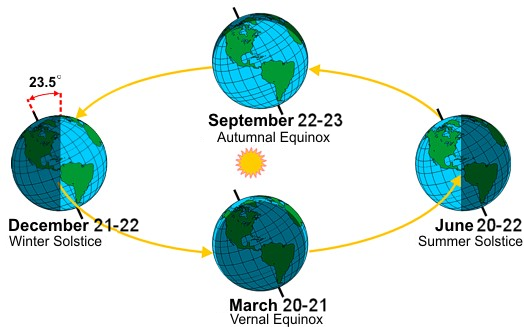Blog

#bioPGH Blog: The Spring Equinox!
 A resource of Biophilia: Pittsburgh, #bioPGH is a weekly blog and social media series that aims to encourage both children and adults to reconnect with nature and enjoy what each of our distinctive seasons has to offer.
A resource of Biophilia: Pittsburgh, #bioPGH is a weekly blog and social media series that aims to encourage both children and adults to reconnect with nature and enjoy what each of our distinctive seasons has to offer.
This coming Monday, all around the world, we will experience something in common: we all will experience approximately twelve hours of sunlight and twelve hours of darkness. Dubbed an equinox, this near uniformity in day and night length marks the first day of spring in the Northern Hemisphere and the first day of fall in the Southern Hemisphere. For us that means warmer weather, picnics in flower-filled meadows, and a baby animal boom! It’s an exciting day on the calendar because we know what’s coming, but let’s dig a little deeper into what’s happening during the spring equinox itself, shall we?
To explore why the equinox is a noteworthy event, we first need to remember that our seasons are the result of Earth’s tilt on its rotational axis — also called its “obliquity.” As we travel around the sun, the Earth is tilted 23.4 degrees. What exactly does this mean? Well, picture that an imaginary line runs from top to bottom through the center Earth, connecting our North and South Pole. Now, imagine that this pole-to-pole line is perpendicular to the Earth’s path in its orbit around the sun — this would be our planet with no axial tilt. However, our tilted axis means that our imaginary line connecting the north and south poles is currently angled by 23.4 degrees.

National Weather Service
Now that we have the Earth’s obliquity in mind, what does this have to do with the spring equinox, also called the vernal equinox? As the Earth progresses in its elliptical orbit around the sun (and remember, the complete orbit takes one year!), this axial tilt keeps the Northern Hemisphere closer to the sun than the Southern Hemisphere for part of the year, and farther from the sun the rest of the year. The equinox that we will experience on Monday is one of only two times during the year when the Earth’s solar terminator (the “boundary” between night and day) lines up perpendicular with the equator. Granted, the night and day lengths are not exactly even, but they are the closest to equal that they will be throughout the year. We mark this as the official change in seasons. Our days in the Northern Hemisphere will grow longer, and in the Southern Hemisphere, grow shorter. (The solstices, on the other hand, are when the Northern or Southern Hemispheres are tilted their furthermost from the sun, giving us our longest and shortest days of the year.)
If we take a step back and think about it, that little tilt of the planet has a pretty big impact. It drives our seasons, our daily amount of sunlight, our circadian rhythms, and many other things related to those concepts. It’s no wonder that cultures and civilizations from around the world and across history have faithfully observed the solstices and equinoxes. These events were followed a by a change in season that would have a tremendous impact on the experience and even survivability of the days ahead. Today, we in Pittsburgh can note the change in seasons with a slightly different outlook than our great-great ancestors may have had, but it’s still important to watch the skies and understand our natural world. We’re all a part of it!
Continue the Conversation: Share your nature discoveries with our community by posting to Twitter and Instagram with hashtag #bioPGH, and R.S.V.P. to attend our next Biophilia: Pittsburgh meeting.
Resources
NASA Space Place: What Causes Seasons?
National Weather Service Seasons
Image credits: Cover, Jay Huang, CC-BY-2.0; Header, Pixabay, public domain

